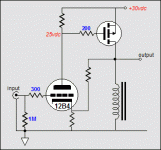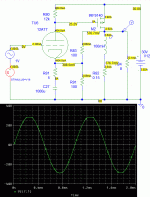article linked on triodes at low voltages (that circuit looks close to a "Bravo" headphone amp
where's the link for it?
http://www.valvewizard.co.uk/Triodes_at_low_voltages_Blencowe.pdf
where's the link for it?
http://www.valvewizard.co.uk/Triodes_at_low_voltages_Blencowe.pdf
Thank you.
What sets the DC current in the MOSFET? Apparently the DCR of the choke lifting the tube cathode. If we assume 28V peak swing we want 3.5 Amps. He has a caveat about choke DCR higher than a third of an ohm, which would be 1V (already high). So we need a tube sensitive to much less than 1V change.
The 12B4 at Mu=6.5, working at 24V, needs 4V of bias. A part-Volt change makes very little difference.
I think this was an end-of-blog throw-away circuit, not fully thought-out. I can "make it work" with a higher-Mu tube, but it feels much too fussy about all device parameters; also I am seeing slewing at 1kHz. (A newer MOSFET would be better, but not a miracle.)
The low voltage is not a killer problem. Tube current falls faster than supply voltage but the MOSFET gate is nominally "zero current". I can get it to stabilize with much less than a mA in the tube. I also have to run it that cool to reduce DC errors in the NFB resistors. However a MOSFET's gate capacitance is large and a cool tube won't drive it fast.
EDIT this works in sim but I do not trust it. Also with the large antique MOSFET the slew is asymmetric and only 0.6V/uS on the downswing.
What sets the DC current in the MOSFET? Apparently the DCR of the choke lifting the tube cathode. If we assume 28V peak swing we want 3.5 Amps. He has a caveat about choke DCR higher than a third of an ohm, which would be 1V (already high). So we need a tube sensitive to much less than 1V change.
The 12B4 at Mu=6.5, working at 24V, needs 4V of bias. A part-Volt change makes very little difference.
I think this was an end-of-blog throw-away circuit, not fully thought-out. I can "make it work" with a higher-Mu tube, but it feels much too fussy about all device parameters; also I am seeing slewing at 1kHz. (A newer MOSFET would be better, but not a miracle.)
The low voltage is not a killer problem. Tube current falls faster than supply voltage but the MOSFET gate is nominally "zero current". I can get it to stabilize with much less than a mA in the tube. I also have to run it that cool to reduce DC errors in the NFB resistors. However a MOSFET's gate capacitance is large and a cool tube won't drive it fast.
EDIT this works in sim but I do not trust it. Also with the large antique MOSFET the slew is asymmetric and only 0.6V/uS on the downswing.
Attachments
Last edited:
Thanks PRR,
I read the page but I still don't really understand the point of the design itself.
It may sound good anyway (or not) but as far as the concept goes, I don't understand what it's supposed to accomplish.
I read the page but I still don't really understand the point of the design itself.
It may sound good anyway (or not) but as far as the concept goes, I don't understand what it's supposed to accomplish.

